AMD Ryzen 7000 Announced: 16 Cores of Zen 4, Plus PCIe 5 and DDR5 for Socket AM5, Coming This Fall
by Gavin Bonshor on May 23, 2022 2:30 AM EST- Posted in
- CPUs
- AMD
- Trade Shows
- 5nm
- PCIe 5.0
- Zen 4
- RDNA2
- Ryzen 7000
- Computex 2022
- X670E
- X670
- B650
- Raphael
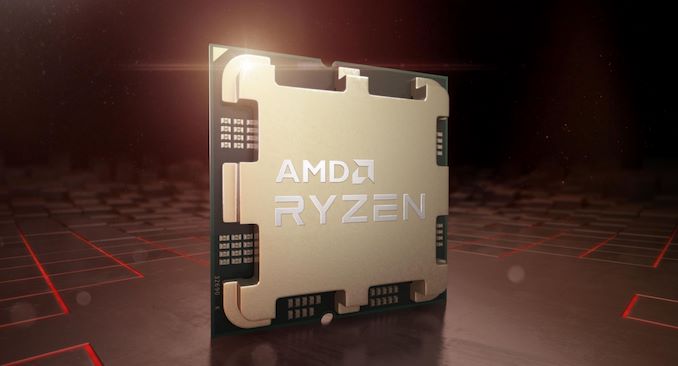
During the AMD Keynote at Computex 2022, its CEO, Dr. Lisa Su officially unveiled their next generation of Ryzen processors and the successor to the highly successful Ryzen 5000 series. The new family, the Ryzen 7000 series, will feature up to 16 Zen 4 cores using TSMC's optimized 5 nm manufacturing process.
AMD Ryzen 7000 also officially marks the end of its long-serving AM4 socket, with the new AM5 LGA1718 socket replacing it with a freshly announced trio of new performance-driven chipsets, including X670E, X670, and B650.
AMD Ryzen: A Brief Recap of Five Years Reinvigorating the Desktop
Since AMD's original Ryzen (Zen) debuted back in 2017, AMD has consistently innovated and progressed its core architecture in a way that before Zen, no one other than AMD itself thought possible. Some of the main advancements that came with Zen included the new AM4 socket, which is undoubtedly one of the most successful in its history and brought DDR4 memory to the mainstream market. In 2018, AMD shipped its updated Zen+ microarchitecture through the Ryzen 2000, based on GlobalFoundries more efficient and optimized 12 nm architecture, along with a notable uplift in IPC performance gains to boot.
Moving forward into 2019, AMD debuted the Zen 2 architecture, which was used as the basis for the Ryzen 3000 series of CPUs. Switching to TSMC's high-performance 7 nm manufacturing process, AMD delivered higher performance levels over Zen/Zen+, with double-digit gains in IPC performance and a completely new design shift through the use of chiplets.
This continued into 2020 when AMD started shipping its Zen 3 core with monumental gains over Zen 2, with up to 19% gains in IPC over Zen 2, as well as the introduction of its Resizable BAR feature, higher levels of L3 cache than ever before, and the introduction of PCIe 4.0 to desktop.
AMD Ryzen 7000: Bringing Zen 4 and 5 nm to Consumer Desktop
The latest in AMD's arsenal, and perhaps one of the most highly anticipated processor announcements of the year, the AMD Ryzen 7000 family has finally been announced with some new features designed to deliver a premium desktop experience. We've known for a long time that the Zen 4 microarchitecture is based on an optimized TSMC 5 nm manufacturing process, but we haven't learned some of the more detailed intricacies until now.
Although the TSMC 5 nm manufacturing process was initially found in smartphones, with Apple and Huawei both championing the transition, Zen 4 marks the first use of 5 nm for x86 desktop systems. The AMD Ryzen 7000 and Zen 4 are similar to Zen 3, including a chiplet-based design, with two Core Complex Dies (CCDs) based on TSMC's 5 nm manufacturing process.
While AMD isn't going into great detail on the Zen 4 architecture today – they have to save something to disucss for later in the year – for now the company is disclosing that Zen 4 will come with 1MB of L2 cache per CPU core, which is twice the amount of L2 cache as found on Zen 3 (and Zen 2) CPU cores. Meanwhile L3 cache will remain a subject for another day; AMD isn't offering details on its L3 cache or whether we will see Zen 4 models with its 3D V-cache stacked packaging.
Coupled with that L2 cache improvement, AMD is aiming for higher clockspeeds, thanks to their architectural design and TSMC's 5nm process. Officially the company is only claiming "5GHz+" max turbo clockspeeds for now, but in a demo video shown by Dr. Su, AMD's pre-production 16 core Ryzen 7000 chip was shown to be boosting to above 5.5GHz, which is a significant uplift from the sub-5GHz speeds of AMD's current Ryzen 5000 desktop chips.
As a result of these cache, architectural (IPC), and clockspeed improvements, AMD is touting a greater than 15% increase in single-threaded performance. And, checking AMD's disclosure notes, this is based on early Cinebench R23 notes, comparing their pre-production 16C Ryzen 7000 chip to a 16C 5950X. Given the significant clockspeed increases that AMD has demoed on this chip, this does imply that most of AMD's performance improvements are coming from the clockspeed improvements rather than IPC uplift. However Cinebench is a single benchmark, and for the moment we don't have any further information on what core architectural changes AMD has made.
Though AMD is disclosing that Zen 4/Ryzen 7000 is getting AI acceleration instructions. Like so many other aspects of the chip, more details are to come, but it sounds like AMD is adding some instructions for manipulating data with common AI data formats such as bfloat16 and int8/int4.
For Ryzen 7000, AMD is also introducing a new 6 nm I/O die (IOD), which replaces the 14 nm IOD used in previous Zen 3 designs. Marking a first for AMD, the new IOD is incorporating an iGPU, in this case based on AMD's RDNA2 architecture. So with the Ryzen 7000 generation, all of AMD's CPUs will technically be APUs as well, as graphics is a basic part of the chip's construction. What this means for the future of AMD's monolithic desktop APUs is uncertain, but at a minimum, it means that all (or virtually all) of AMD's CPUs will be suitable for use in systems without discrete graphics, which although not a huge deal for consumer systems, is very much a big deal for corporate/commercial systems.
| AMD Desktop CPU Generations | |||
| AnandTech | Ryzen 7000 (Raphael) |
Ryzen 5000 (Vermeer) |
Ryzen 3000 (Matisse) |
| CPU Architecture | Zen 4 | Zen 3 | Zen 2 |
| CPU Cores | Up To 16C / 32T | Up To 16C / 32T | Up To 16C / 32T |
| GPU Architecture | RDNA2 | N/A | N/A |
| GPU Cores | TBD | N/A | N/A |
| Memory | DDR5 | DDR4 | DDR4 |
| Platform | AM5 | AM4 | AM4 |
| CPU PCIe Lanes | 24x PCIe 5.0 | 24x PCIe 4.0 | 24x PCIe 4.0 |
| Manufacturing Process | CCD: TSMC N5 IOD: TSMC N6 |
CCD: TSMC N7 IOD: GloFo 12nm |
CCD: TSMC N7 IOD: GloFo 12nm |
The new IOD also affords AMD the opportunity for some significant platform power savings. Not only is TSMC's 6nm process well ahead of GlobalFoundries' old 14nm process, but the design process has allowed AMD to incorporate many of the power-saving technologies that were first developed for the Ryzen 6000 Mobile series, such as additional low power states and active power management capabilities. As a result, Ryzen 7000 should fare much better at idle and low utilization workloads, and it's a reasonable assumption to see the IOD drawing less power at load, as well (at least with graphics disabled). Though at full load, with up to 16 cores running at over 5GHz, the CCDs are still going to draw a lot of power.
On the matter of power, it's also noteworthy that AMD is indicating that Ryzen 7000 will operate at higher TDPs. While AMD isn't announcing official SKUs at this point, they are explicitly noting that the new AM5 platform is designed for nominal chip TDPs up to 170 Watts, with peak power consumption (Package Power Tracking) allowed to hit 230 Watts. Whether or not motherboard vendors will go beyond this on its X670E, X670, and B650 motherboards remains to be seen at this point.
Last, but certainly not least, AMD's Zen 4 microarchitecture combined with the new IOD also brings about a host of new features, including official support for PCIe 5.0, much like Intel introduced with its Alder Lake (12th Gen Core) architecture. Combining AMD Ryzen 7000 with an X670E, X670, or B650 motherboard will provide up to 24x PCIe lanes split between slots and storage devices. Based on AMD's disclosures, it sounds like all of the lanes coming off of the Ryzen 7000 chip itself will be PCIe 5.0-capable, but it will be up to motherboard manufacturers to actually design their boards to support PCIe lanes at the highly-sensitive 5.0 speeds. As a result, Ryzen 7000 chips plugged into some lower-end motherboards will only offer a far more limited number of lanes at PCie 5.0 speeds, with the rest operating at PCIe 4.0 speeds.
AMD's AM5 Platform: Socket LGA1718 with Three New Chipsets – X670E, X670, and B650
As the announcement of AMD's Ryzen 7000 family of processors officially brings the previous AM4 platform to an end. Ryzen 7000 will be the first family of processors using AMD's new AM5 platform, which AMD is also disclosing the first deals of today. Using a LGA-type socket with 1718 pins, AM5 is the other piece of the puzzle in introducing DDR5 and PCIe 5.0 support, as well as higher processor TDPs.
The big news on the I/O front is of course PCIe 5.0 support. This is intended to be used to drive next-generation video cards (and other accelerators) as well as next-generation SSDs, with AMD expecting the first PCIe 5 consumer SSDs to be avaialble just in time for the AM5 platform launch. With up to 32GB/sec of bandwidth in each direction, PCIe 5.0 will offer a lot of bandwidth, but its very tight signal integrity requirements are also in part what required AMD to move to a new socket, with LGA apparently being a better fit.
AM5 also brings quad-channel (128-bit) DDR5 support to AMD's platforms, which promises a significant boost in memory bandwidth. And, in an interesting move, AMD is offering only DDR5 support. Unlike Intel, whom we saw support both DDR5 and DDR4 with its Alder Lake platform last year, AMD is not including any kind of support for older memory formats here.
Given the high-level nature of today's disclosures, AMD unsurprisingly isn't talking about supported memory speeds. But based on their testing footnotes for their pre-release processor performance claims, we see that AMD did test with DDR5-6000 memory. So while almost certianly using overclocked (XMP) memory there, it implies AM5/Ryzen 7000 has some memory overclocking headroom to offer.
One interesting thing that we've already mentioned is that AMD Ryzen 7000 will move to support processors up to 170 W TDP on Zen 4, as opposed to 105 W TDP found on processors such as AMD's previous Ryzen 9 5950X. AMD is also using a new heat spreader (IHS) design on Ryzen 7000, which AMD has done to allow compatibility with previous socket AM4 coolers. This means that theoretically, users looking to upgrade to Ryzen 7000 will be able to use pre-existing coolers with socket AM4 support.
Supporting the new AM5 platform will be a trio of new new motherboard chipsets: X670E, X670, and B650. Starting with the flagship X670E 'Extreme' chipset, this is designed for its most premium models, focusing on extreme overclocking, with a full loadout of PCIe 5.0 support – meaning support for two PCIe 5.0 graphics slots, as well as at least one PCIe 5.0 M.2 slot for storage. Which from AMD's specifications we can infer would be in a x8/x8/x4 loadout, using PCIe lane bifurcation to split off 8 lanes from a first PCIe x16 slot to a second slot when both are in use.
Interestingly, AMD differentiates X670 into two market segments compared to previous iterations such as X570, X470, and the X370 chipsets. While both the X670E and X670 cater to enthusiasts, X670 is designed to be a slightly downmarket offering, taking a step back in the amount of functionality motherboard vendors are expected to offer with those boards. In particular, X670 does not require PCIe 5.0 support for the PCIe x16 slots – while many boards will offer it, an X670 board would also be allowed to implement PCIe 4.0 instead. Do note, however, the PCIe 5.0 is still required for at least one M.2 slot for NVMe SSDs.
Between the two versions of the X670 chipset, it seems as though the most premium models such as ASUS's ROG Crosshair series, MSI's MEG series, and GIGABYTE's Aorus Xtreme series will be based on X670E, in order to separate it from the more mid-range focused and more widely affordable X670 options.
| AMD AM5 Chipset Comparison (Preliminary) | |||
| Feature | X670E | X670 | B650 |
| CPU PCIe (PCIe) | 5.0 (Mandatory) 2 x16 Slots |
5.0 (Optional) | 4.0 |
| CPU PCIe (M.2 Slots) | At Least 1 PCIe 5.0 Slot | ||
| Total CPU PCIe Lanes | 24 | ||
| SuperSpeed USB 20Gbps (USB 3.2 Gen 2x2) |
Up To 14 | ||
| DDR5 Support | Quad Channel (128-bit bus) Speeds TBD |
||
| Wi-Fi 6E | Yes | ||
| Overclocking Support | Y | Y | N |
Finally, we have the B650 chipset. As with previous AMD B-series chipsets, will target mainstream users with more affordable options. Like the rest of the AM5 chipsets, B650 requires PCIe 5.0 support for at least one M.2 slot for storage, while it does away with PCIe 5.0 support for PCIe slots entirely. It also doesn't have any overclocking support explicitly mentioned. At a high level B650 sounds a lot like X670 with overclocking enabled, but we'll have to wait to hear from AMD and motherboard vendors for more explicit details.
Along with the announcement of X670E, X670, and the B650 chipsets, AMD has announced some of the most premium motherboards we can expect to see for the launch of Ryzen 7000. This includes a range of flagship and premium X670E boards from families we've seen many times before, including the ASRock X670E Taichi, the ASUS ROG Crosshair X670E Extreme, the Biostar X670E Valkyrie, the GIGABYTE X670 Aorus Xtreme, and the MSI MEG X670E Ace motherboards.
We don't have any official specifications from motherboard vendors regarding the announced models at the time of writing. Still, we expect to start receiving specifications, controller sets, and power delivery information very soon.
On the power delivery front, AMD has confirmed that AM5 will support AMD's Serial Voltage 3 (SVI3) standard. First introduced as part of the Ryzen 6000 Mobile series, SVI3 allows for finer grained power control and significantly faster voltage response capabilities. And for desktop boards in particular, SVI3 also supports a larger number of power phases, which will be especially useful for high-end X670E motherboards.
Rounding out the AM5 platform, since all of AMD's Ryzen 7000 CPUs will have integrated graphics, AM5 as a whole has graphics support baked into every tier of motherboards. AM5 motherboards will be able to support up to four display outputs using a mix of HDMI 2.1 and DisplayPort 2.
Finally, the platform will come with an upgrade to AMD's USB capabilities, though seemingly not as much as we had first hoped. According to AMD, the platform supports up to 14 SuperSpeed USB 20Gbps (USB 3.2 Gen 2x2) Type-C ports. Notably, AMD isn't saying anything about USB4 here, so while 20Gbps ports are nothing to sneeze at, it doesn't look like AM5 will offer the higher speeds and other perks of USB4 – at least not with this first generation of products.
AMD Ryzen 7000 Desktop Processors: Coming Fall 2022
Last but not least, let's talk about availability.
While AMD is eager to announce their upcoming desktop CPUs, today's announcement is essentially one big teaser – whetting the audience's appetite by showing off the first details of the Ryzen 7000 chips and the AM5 platform. The actual launch date of AMD's new platform won't be until sometime in the fall, somewhere between 4 and 7 months from now.
This does make the Ryzen 7000 announcement a fairly early one, but it's not something that's out of character for AMD. With the Zen 4 CPU architecture already slated to launch in 2022 (per AMD's roadmaps), this is something the industry has known would be coming sooner or later. And with Intel passing on this year's Computex (they're barely mid-generation on Alder Lake), it lets AMD take the center stage with respect to PC GPUs. Put another way, for AMD it would have been a waste of a perfectly good Computex to not announce the platform, especially as their Taiwanese motherboard partners are eager to show off some new products.
In any case, expect to see AMD drip feed further information about Ryzen 7000 and the AM5 platform over the coming months. The company has a lot left they want (and need) to say about their upcoming hardware, and with the initial announcement coming at Computex, they now have all summer to say it. And we, for one, are very much interested in hearing it. So stay tuned for the further details to come on AMD's next-generation desktop platform, and our first look at the Zen 4 architecture.



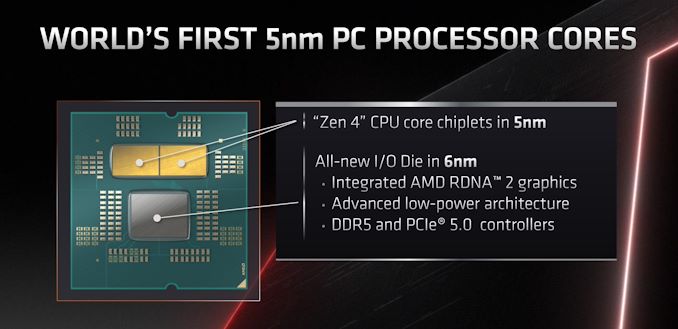
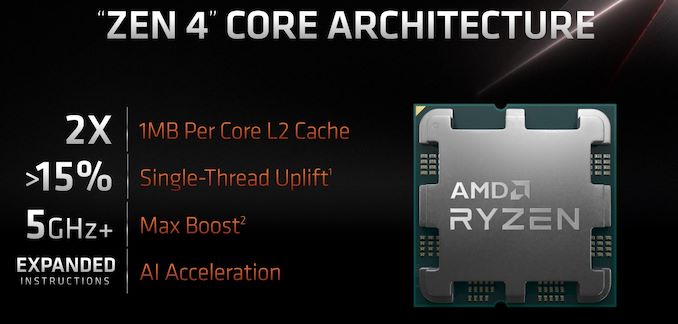


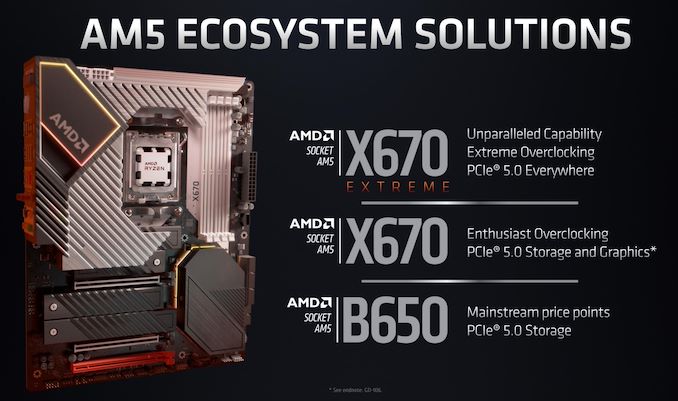
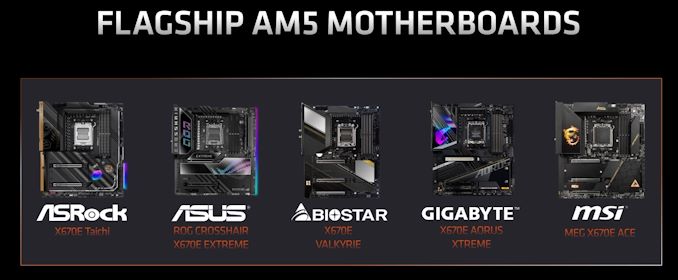
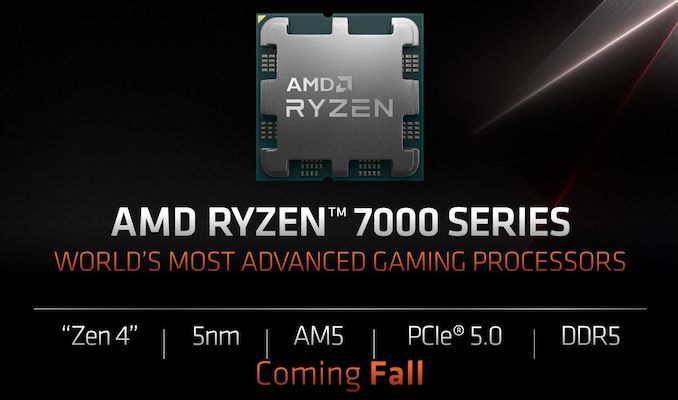














332 Comments
View All Comments
Kangal - Thursday, May 26, 2022 - link
It was a worthwhile investment.They would have to leap on that AVX-512 some day, and this way they can just do it and get it out of the way. And the sooner the better, as software adapts to it. If anything this was the perfect time. It's on a brand new platform, and they have plenty of performance and efficiency on the table to waste. Intel is going to be dominating them with the 12th-gen and 13th-gen products.
AMD still has options such as:
- slight tweaks to Zen4 - overclock it - add more cores per chiplet - add their X3DCache - remove the iGPU - use the AVX-512 perhaps more in software at that point.
....So they can easily sit on this Zen4/Zen4+ for the next 2-3 years, buy themselves some time, until Intel becomes a threat. Then they can respond swiftly with their Zen5 or whatever they want to call their New-Architecture that they've been working on.
Meanwhile, Apple is going to smoke every competitor with their A16-family, all the way from the Silicon in their Watch, to Mini Phone, Large Phone, Tablet, Ultrabook, Laptop, and Desktop offerings. And possibly even an Apple Cloud service against Intel's Xeon, AMD's Epyc, Amazon's Graviton, and the Ampere Altra lineup.
Slash3 - Sunday, May 29, 2022 - link
Die area isn't as much of a concern for AVX512 as most people think. It's on the order of 1% of the total die area for a 12900K. It does add about 10-15% to an FPU/SIMD block, but you can see from annotated die shots that it's still a comparatively small portion of the 12900K die.https://pbs.twimg.com/media/FCvOcnYXIAInJhh?format...
And here, a comparison between Skylake and Rocket Lake (both on 14nm, the latter of which added AVX512)
https://pbs.twimg.com/media/E2GW2NWXIAUbdBK?format...
Slash3 - Sunday, May 29, 2022 - link
(~37% increase for each FPU/SIMD unit, ~10-15 for the total die cluster area - I phrased it a bit awkwardly above)gruffi - Tuesday, May 24, 2022 - link
Nonsense. They didn't cherry pick anything. They used CB R23 ST which is even something like Intel's ST best case scenario. And they didn't say 15%, they said >15%. Depending on the clock speed it could mean ~10% IPC improvement. Though that's still underwhelming after two years. People expected more like 15-20%. OTOH 46% faster than 12900K in Blender is quite good.whatthe123 - Tuesday, May 24, 2022 - link
it's not the best case for intel ST. it's the best case for both companies in ST since its lean on everything but FP demands.best case for intel would be CB MT, but for MT testing they used blender where performance varies a lot depending on scene rendered.
deepblue08 - Wednesday, May 25, 2022 - link
Yeah...and the 5% IPC improvement is probably the increase in L2 cache and maybe a bit from DDR5peevee - Friday, May 27, 2022 - link
There is nothing 5nm about the transistors. They are about the same size as the old "32nm" transistors...BillBear - Monday, May 23, 2022 - link
>Zen 4 marks the first use of 5 nm for desktop systems.The M1 Mac Mini is built on TSMC 5nm and has been shipping since 2020.
Trackster11230 - Monday, May 23, 2022 - link
The article may have been corrected after your comment, but it now states for x86 systems.Hifihedgehog - Monday, May 23, 2022 - link
The official slides state "first 5nm PC processor cores." I really wish Ian was back. He was much better at seeing nuance like this.